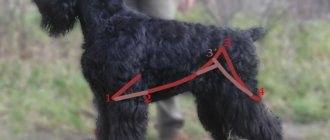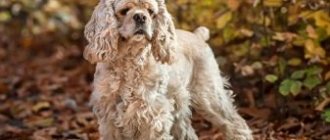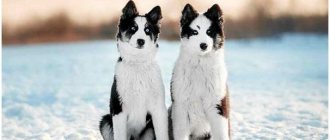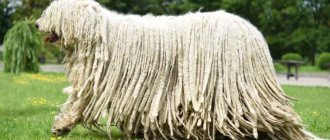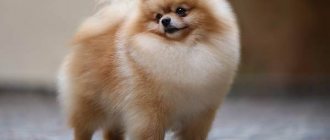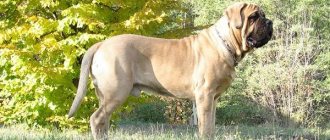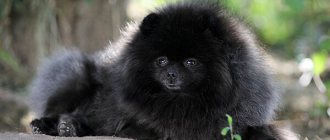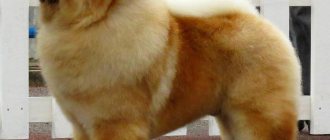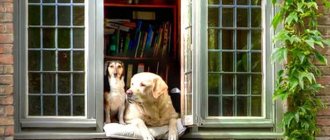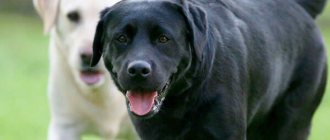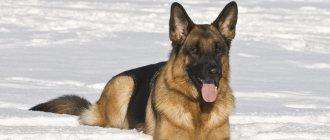Curly-haired dogs are one of the most distinctive breeds in the world. And despite the prevalence of poodles and labradoodles, true curly hair in dogs is not that common. To have curly hair, a puppy must inherit two KRT71 gene mutations —inheriting just one will result in wavy hair rather than curly hair. So your curly-haired puppy is truly a rare breed of dog!
Many curly breeds were bred either as water dogs to aid fishermen or rescue people on the water, or as herding dogs to work in cold, wet climates such as the British Isles. These working dogs may not have spent much time at the groomer, but most curly-haired breeds today require a fair amount of grooming to keep their coat clean and healthy. Many curly breeds are either non-shedding, hypoallergenic, or both, making them an ideal choice for allergy sufferers .
Do you want to get a curly puppy? Check out the most popular, quirky and unusual dog breeds with beautiful curly locks. And remember, you don't have to look for a purebred dog—there are plenty of curly-haired puppies at local shelters.
Poodle
Whether a standard, miniature or toy poodle, he will always have curly hair. Whatever their size, they remain one of the most adorable dog breeds in the world. Originally bred to pull ducks out of the water, these curly-coated four-legged companions are now prized for their proud bearing and curious facial expressions.
Additionally, Poodles are hypoallergenic and non-shedding, making them an ideal option for people with allergies. Young poodles love to get a lot of exercise and are always willing to fetch a stick or ball. Poodles need regular trimming and brushing to prevent their coat from matting easily and quickly.
Features of caring for a curly pet
Connoisseurs of curly pets do not cut their hair bald. Therefore, to emphasize the beauty of the dog, you will have to tinker with long hair. Each breed has its own characteristics and nuances. But any one will have to be cut, combed and bathed.
Important! If you don't have time to care for your dog, don't get a curly-haired puppy.
Walking by four-legged animals inevitably leads to tangles. The result is aesthetic problems and a negative impact on health: parasites, harmful bacteria get into the wool and heat exchange is disrupted. Regular brushing of the dog improves blood circulation, removes dead hairs and parasites, evenly distributes the fat layer and gives the animal pleasure. One brush is not enough. For combing different breeds use:
- The Furminator is a miracle of modern technology. Outwardly, it resembles a blade from a hair clipper on a comfortable handle. Quickly and efficiently eliminates dead undergrowth. Suitable for any hair length, as long as there is an undercoat. Gives pets pleasure and lasts a long time.
- Puhoderki - serve the same purposes as the furminator. Suitable only for animals with voluminous fur.
- Metal combs - finish the job after previous tools. Effective only for long-haired dogs.
- Massage brushes - used for styling hair. More convenient options are in the form of a glove.
- Scissors - sometimes tangles have to be cut off.
If the previous procedure is not enough for the dog, we move on to bathing. Contrary to expectations, a curly dog may not appreciate this prospect. Accustom this breed to water procedures from puppyhood. Some tips:
- First we comb it, and then we bathe it. Reverse order is ineffective.
- Choose a warm, draft-free room for your procedures.
- Pour water in advance and up to the middle of the paws.
- Monitor your dog's temperature.
- Don’t push immediately, let the dog get used to the situation.
- First, water the wool using a ladle. Showers are only for calm and accustomed animals.
- Don't overuse shampoo. Detergents degrease the skin of four-legged animals, it cracks and dries. The result is hair loss and allergies. Therefore, choose mild or specialized shampoos.
Note! It is strictly not recommended to dry some dog breeds, for example long-haired ones.
Airedale
Originally bred by Yorkshire breeders and used for duck hunting and rodent control, Airedales - the largest terriers in their group - still retain a strong hunting instinct. And while they are sweet and loyal, mischievous dogs, they can also be stubborn and difficult to train. Their coarse, tightly curled coat requires regular brushing, but Airedale Terriers usually only need clipping a few times a year. They also shed little and are compatible with allergy sufferers.
Portuguese water dog
Remember Bo, the Obamas' beloved dog during their time in the White House? He was chosen for the family because of his daughter Malia's allergies - curly-haired Portuguese water dogs, although they shed, are hypoallergenic. These medium-sized dogs were bred to fish in nets, and their thick coats made them immune to cold water temperatures. Today, these sweet, easy-to-train family dogs require daily brushing and occasional trimming to keep hair out of their eyes.
Content Rules
Curly-haired friends can live in an apartment or small house without any problems, but it is advisable to take them for walks. Usually 2 such walks are enough: in the morning and in the evening.
If it is not possible to go outside with your dog often, then it is better to get small breeds and put a litter box for them in the apartment. But even after this, the pet will need walks for good health.
The diet should be varied, but it is advisable to limit the intake of fatty foods.
You can include in your diet:
- rice porridge;
- sea fish;
- beef;
- fruits;
- kefir;
- cottage cheese.
Following these simple recommendations will help your child grow up beautiful and healthy.
A dog is a friend, a hunter, and sometimes just a cute fluffy dog. Curly-haired dogs especially deserve this name. They attract attention, are different from others, but require special care.
Bullets
If you've ever met a Puli dog, they've probably made a big impression on you. This breed's long, curly hair naturally forms dreadlock-like curls, giving it the appearance of a four-legged mop .
The Puli's coat can be left corded, or combed so that it resembles a giant puffer coat, or trimmed short - although this should only be done by a professional groomer. Originally bred as herding dogs to withstand cold and icy water, these friendly family dogs are playful and obedient.
Weimaraner
Weimaraners are elegant dogs that are always ready for adventure. They need plenty of exercise and love to play with their people. This breed is incredibly loving and easy to train , making Weimaraners excellent family dogs as long as they get enough exercise.
Curly coated retriever
The coat of the Curly Retriever is simply amazing. Highly prized as hunters for their ability to withstand water, snow, thorny underbrush and other hostile conditions, these large dogs are covered in tight curls that rarely need to be trimmed and should not be brushed . Instead, a grooming rake is all they need. Extremely intelligent and full of energy, these beauties need regular exercise and mental stimulation.
Bloodhound
Also known as bloodhounds, bloodhounds are the best dogs for finding missing persons. Their sharpest sense of smell in the canine world can sometimes cause trouble on walks, as they tend to sniff everything. Besides their long, floppy ears (which should be checked daily for ear infections), these hounds have a love of barking like no other. They howl at everything, which is why Bloodhounds are not the best choice for families living in cramped apartments.
Fun fact: Bloodhounds can track up to 210 km away and can follow a scent left almost a week ago. Often used in search and rescue missions, Bloodhounds are considered such accurate trackers that their tracking results can be used in court.
The long, floppy ears are an advantage for the sensitive noses of bloodhounds and add to their charming, soulful appeal. Who wouldn't want to pat the ear of this sweet pie with a sad look?
Barbet
If you are a lover of cute dogs with hair accessories, then the barbet is for you. Barbets with long, shaggy hair in a variety of colors are often found wearing a clip or hair band to keep hair from getting into their eyes.
These friendly, playful dogs, although they don't shed much, require brushing about once a week to keep their thick fur from matting. Intelligent and energetic, Barbets love to swim and need constant exercise and exercise to avoid creating chaos in your home.
Labradoodle
Although not a recognized "official" breed, Labradoodles - a cross between a poodle and a Labrador retriever - are among the most popular "mutts" in the world. Whether your Labradoodle has curly, wavy, coarse or straight hair depends on how much of the KRT71 gene he inherited from his Poodle ancestor. But whatever the coat, the Labradoodle does not shed, but requires regular brushing. Keep these playful, active dogs occupied and don't let them feel lonely—they are definitely people-oriented dogs!
The rarest and most expensive breeds in Russia
Of the four hundred recognized dog breeds, there are also some that most Russians have never even heard of; Among them, for example, are the following rare breeds:
- Catahoula Leopard Dog;
- Xoloitzcuintle;
- wild dog;
- Peruvian Inca Orchid;
- blue Thai Ridgeback;
- moody
These and some other dog breeds are practically unknown and unclaimed, so it is not possible to review their value on the Russian market. But we can name breeds, the average cost of which in Russia is especially high, and sometimes even exceeds global indicators:
- French bulldog - $500;
- chow chow - $550;
- Shar Pei - $600;
- German Shepherd – $600;
- Yorkshire Terrier - $800;
- Pomeranian Spitz - $1000;
- Pharaoh Hound - $1200;
- Tibetan Mastiff - $1600;
- rabbit dachshund - $1700;
- Alaskan Klee Kai - up to $2700.
Video: the most expensive and prestigious breeds
A prestigious pet of a rare and expensive breed will more than once please the ambition of its owner and become a living calling card of his success. But in order to warm your soul and get great pleasure from communicating with a dog, it is not at all necessary to purchase the most expensive of them.
Spanish water dog
These intelligent, agile, but goofy-looking dogs have long, mop-like fur that can be “knotted” like bullets in the hands of a professional groomer. Otherwise, Spanish Water Dogs will need to be trimmed once a year or regularly, depending on the owner's preference. Their coat should not be brushed, but rather left to curl naturally. Because these cuties have a strong herding instinct and love to do "work", they need plenty of exercise and do well with an active owner.
Devon Rex
In the 60s, a kitten appeared in Britain that was unusual and captivated everyone. This was the result of a gene mutation and mating with the Cornish Rex breed. The appearance of the resulting cats frightens some, but pleasantly impresses others.
The pet is small in size, has huge, widely spaced ears, its muzzle is flat, and its nose is snub-nosed. Devon fur is soft and hypoallergenic. These animals are active - they run, play, jump, and climb to heights.
Best articles: Antagonism (biology): characteristics and types
Thanks to their developed intelligence, Devons are trainable. Since these are small cats, they need to be treated with care.
It is especially important to protect them from drafts. Such cats in the apartment
Bouvier des Flanders
Life just got a lot easier for the Bouvier des Flanders. Bred to be a hard-working farm dog, this curly-haired, wavy-coated breed originated in what is now Flanders, Belgium. The breed was almost destroyed as a result of the First and Second World Wars, but breeders managed to restore its population. Today, the Bouvier des Flandres is a popular family dog that is particularly good with children and is also a surprisingly good guard dog. Bouviers des Flandres need a place to entertain, so a large fenced yard suits them best. Daily teeth brushing is a must!
Choosing a puppy
There are many types of curly-haired dog breeds, so before buying a puppy you should decide for what purpose it will be purchased:
- The role of family friend is well performed by small breeds that love children.
- For protection, it is still better to take large curly dogs.
It is also advisable to pay attention to the behavior of puppies; healthy dogs should be active and playful.
An important role when choosing a pet is played by the place of purchase, as well as the conditions of its stay. In a regular animal market, you can buy a pet for pennies, but there is a chance that you will not get a purebred baby.
Puppies purchased from a shelter are usually raised in good conditions by experienced dog breeders, so these four-legged dogs will be easier to own in the future. In addition, such dogs must have a passport and pedigree.
Kerry Blue Terrier
These robust, tall dogs have a unique bluish-gray coat that is soft and tightly curled, with no undercoat. Originally bred as rodent hunters and later used as herding dogs, Kerry Blue Terriers are now loyal family pets. They do best with obedience training when they are young. Their beautiful fur requires frequent brushing, as well as grooming - at home or by a professional - approximately every six to eight weeks.
Tosa Inu
Brave fighting dogs were bred in the Japanese province of Tosa specifically to participate in dog fights in the ring. The traditions of fights are maintained in Japan even now, but the dogs do not bite each other, but press with weight, like in sumo.
The lower limit of the height of the top at the withers for females is 55 cm, for males – 60 cm.
Body weight is from 40 to 90 kg, but 100 kg is not uncommon for adult males. The coat is dense and short. Classic colors - red, apricot, black, brindle.
Despite its developed fighting qualities, Japanese dog handlers consider the Tosa Inu to be an excellent home companion, and owners trust them to nurse children. Dogs have developed territorial and protective instincts; even without training, they make vigilant watchmen and fearless bodyguards.
Pumi
Pumi were bred in Hungary as hard-working herding dogs. They still love to be busy either with herding chores or endless games of tag . Luckily, caring for your Pumi's softly curled coat won't take too much of your time. These curls need to be brushed several times a week and then wetted to bring the curls to life. You may want to trim your pet's fur from time to time, especially around the face, but regular trips to the groomer are not necessary for this energetic breed.
Setter
There are several different setter breeds, including the Irish Setter, Scottish Setter and English Setter - all of which have floppy ears. Setters are native to the United Kingdom and Ireland and are ideal for those who enjoy hiking and hiking . Setters are happy when they have the opportunity to run through forests and fields, up and down hillsides.
IMPORTANT! Setters like to keep an eye on their surroundings, looking out for intruders. This same desire to guard their space can make them want to prowl, so it is recommended to keep these sweet sporting dogs on a leash or in a secure, fenced yard.
Bedlington Terrier
Are you ready for a Bedlington Terrier to come into your life? It's worth preparing! This cute little terrier's energy is something to be envied. The Bedlington Terrier is easily recognized by its pear-shaped head, arched back and fluffy coat that makes it look like a lamb. This breed does not shed, but needs to be brushed several times a week to keep the coat from matting. Many owners like to cut their Bedlington Terrier's hair to help define its body shape more clearly. These loyal dogs love nothing more than to frolic and play , especially with small children.
Breed standard Russian Tsvetnaya Bolonka
The exterior of the representatives of the breed is emphatically pretty. Glamorous curly “fur coats”, round cherry eyes and a compact, slightly elongated body – all together this forms a unique type of image pet. The optimal height of today's Russian colored lap dog is 26 cm. Moreover, this figure is desirable for both females and males, although earlier standards indicated sexual dimorphism as a mandatory requirement for the exterior.
Deviations from the growth norm are permissible, but no more than a couple of centimeters - “Gullivers” and “dwarfs” are not allowed for breeding in nurseries. An exemplary flowering plant weighs 3-4 kg. As for the coat, the requirements for it have also undergone changes. If Soviet lap dogs were required to have exclusively curly hair, then for modern individuals a wavy hair structure has become an acceptable option.
Head
The skull is convex, slightly rounded, with prominent apple cheekbones, non-protruding brow ridges and the same occipital protuberance (bump). Short type stop, easy to identify. The muzzles of Russian colored lapdogs are short, dry, with straight backs. The base of the muzzle is quite wide, the tip is slightly narrowed.
Teeth, lips and jaws
Representatives of the breed have wide jaws that form a scissor-type bite in the bow, instead of which a tight overshot and pincer-like (straight) bite are also allowed. Ideal indicators of dental health are their white color, as well as their close arrangement in a row. The lack of fangs or incisors in the jaw is a serious defect in the exterior. The neat thin lips of the animal are pigmented black or to match the color.
Nose
With fairly miniature lobes, the dog’s nostrils are large and wide open. The skin of the nose can be colored to match the coat or have an anthracite-black color.
Eyes
The almost round eyes of Russian colored lapdogs are complemented by straight posture and dark irises. If the animal's fur is brown, a slight lightening of the eye color is allowed. The thick, dry skin of the eyelids is pigmented in coal black or any other shade in accordance with the color. The look of the breed is touchingly friendly, radiating positivity.
Ears
The shape of the lap dog's ears is triangular, with a flattened miniature tip. The characteristic position of the ear is hanging down on the cartilage with a moderately high set.
Frame
Russian colored lapdogs are compact dogs, but with a fairly wide body. The animal's back gives the impression of being smooth, elongated and muscular, while a slight slope of the topline is noticeable in the segment between the withers and the root of the tail. The convex short loin ends in the croup, which is characterized by moderate sloping and rounded contours. The chest, shaped like a regular oval, is of good length and descends almost to the elbows. RCB's belly is not tucked too high.
Limbs
The main features of the legs of the Russian colored lapdog are parallelism to each other and relatively wide set. The oblique scapulae are the same length as the humerus, creating an articulation angle of 100-110°. Straight forearms are held level, the contours of the wrists fit into the vertical formed by the skeleton of the forearms.
The thighs of the representatives of the breed are not very long, but with quite prominent muscles. The angles of the knee joints are normally expressed, the shins are of normal, not excessive length. The hock joints are strong, dryish, with clear angular joints. The short hocks in the stance are fixed in a vertical position. The lapdog moves at a free, energetic trot.
Tail
The tail, laid on the back or curled into a ring and thrown over the croup, is covered with abundant hair. A prerequisite is that the tip of the tail is always in contact with the dog’s body.
Wool
All individuals have wavy or large curled fur. The hair is long, evenly distributed over the body, with an insignificant or sufficient amount of undercoat. Abundant decorative fur grows on the forehead. Russian colored lapdogs are not cut or trimmed. Hair shortening is possible only on certain areas of the body for hygienic purposes.
Coat colors
Representatives of the breed can have any color, with the exception of white, harlequin and spotted colors. However, subtle white markings on the throat, chest, chin and fingertips are acceptable.
Disqualifying defects in appearance and behavior
- Unreasonable shyness and aggressiveness.
- Missing decorative hair on the forehead.
- Heterochromia of the iris, blue eyes.
- Twisted jaw, underbite.
- Loosely covered lips, visible incisors and fangs.
- Non-standard type of coat color.
- Height over 28 cm.
- Dwarf dimensions.
- Boobtail.
Bichon Frize
If you're partial to dogs that look like stuffed animals, are hypoallergenic, and don't shed, then perhaps it's time to welcome a Bichon Frize into your home. With incredibly adorable faces and fluffy white fur, they are one of the most popular curly-haired dog breeds. The Bichon Frize loves spending time with its family and is an excellent apartment dog . But keep in mind that he needs regular trips to the groomer and almost daily brushing to keep his fluffy coat from turning into a tangled mess.
Origin story
The Podenco Ibicenco is a primitive type greyhound dog. Its closest relatives are the Portuguese, Canarian, Andalusian Podenco, as well as the Cirneco dell'Etna and the Pharaoh Hound. Historians are inclined to believe that dogs of this type were brought to the islands of the Blair archipelago from North Africa by the Phoenicians, who founded a settlement in Ibiza in the 8th century BC. The Carthaginians and Romans also probably played a role in the spread of dogs from the Middle East. The ancient ancestors of the Podenco Ibicenco are considered to be the pointy-eared dogs depicted on Egyptian frescoes. In this case, we can safely say that the Ibicenco Podenco is an ancient hunting breed of dog that was formed on the islands of the Blair archipelago (Mallorca, Ibiza, Menorca, Formentera), where they were used for unarmed hunting of birds, rabbits and even larger game. In its homeland, the breed is known under its original name “ca eivissec”. Modern genetic studies conducted in 2004 have given reason to believe that the Ibicenco Podenco as a breed was formed relatively recently and is similar to ancient Egyptian dogs only in appearance.
Ibicenko was one of the first dogs of the Mediterranean, which interested dog handlers, first of all, for its appearance. Noticing the similarity with ancient Egyptian dogs, the Podenco began to be called “Pharaoh’s Hound.” The FCI system approved a standard for them, which was in force from 1963 to 1977. In the early 70s, the British became interested in the greyhound from the island of Malta and registered it in their English Kennel Club under the same name - “Pharaoh Hound”. Naturally there was confusion. FCI yielded to the authority of their British colleagues and canceled their standard. Fortunately, the breed was not forgotten. In mid-1956, the first Ibizan greyhounds came to America (Rhode Island), which subsequently played a significant role in their popularization. At the same time, they continued to be bred in their homeland and in neighboring countries. In 1982, the FCI recognized the breed again, but under a new name - Podenco ibicenco. Today the main population is concentrated in the countries of southern Europe and the USA.
Purpose
Podenco Ibicenco is a greyhound that is used for unarmed hunting of rabbits at any time of the day, because it hunts not only with the help of sight and hearing, but also uses a sensitive sense of smell. Seeing or smelling an animal, they instantly become excited. The chase is very fast and exciting. At the same time, it has a soft grip. Unlike other greyhounds, it can bring prey alive, rather than strangling it on the spot. Thus, the Podenco Ibicenco is a greyhound with some qualities and habits inherent in hounds and retrievers.
Podenco Ibicenco can hunt independently and in a pack of up to 15 dogs. In a quarrel, only bitches work and no more than one cable, as they are grumpy and can be distracted by sorting things out even during the hunt.
When one of the dogs detects prey, the others surround and wait for the moment when they need to join in the baiting. Podencos need a long rest; after a successful hunt, they refuse to work for some time.
In addition to being a hunting dog, in many countries around the world the Podenco Ibicenco is positioned as an excellent companion and a spectacular show dog.
Video about the Podenco Ibicenco dog breed:
Irish Water Spaniel
With the muzzle of a cocker spaniel and the size and coat of a standard poodle, the Irish Water Spaniel is a hypoallergenic playmaker with boundless energy and agility. Natural swimmers with webbed feet , these dogs appreciate the opportunity to splash around in a pool or lake. Their coat contains oil, which makes it water-repellent, but also retains dirt, so the Irish Water Spaniel needs frequent brushing, as well as periodic trimming at home or at the groomer.
Where can I buy
There are various ways to become the owner of a pocket breed dog. It all depends on who she will be in the family - a home companion or a participant in exhibitions.
For ordinary owners
The main advantage of such a purchase is a reduced price, but ordinary owners are not responsible for purebred breeding and impeccable genetics. Therefore, the risk of genetic diseases in tiny creatures is very high.
If you need a purebred dog, you should avoid this method of acquisition, despite the obvious benefits.
The Coton de Tulear is a wonderful pet and companion.
In the nursery
This is the most reliable option for buying a purebred puppy. You can first check the documents to find out who the parents were. This is the method chosen by those who dream of a show career for their pet.
By advertisement
Various advertisements can be found on Yula, Avito and other resources. There is a great risk that they will try to pass off a simple dog as a purebred animal, but this is not the worst thing. You can even buy a sick puppy. Some irresponsible sellers try to pass off an ordinary dog as a pocket dog.
For free
This method does not always mean that the intentions of the former owners are bad. It is quite possible that the child has developed a severe allergy that makes keeping a dog impossible. Or the family moves. Therefore, you should not be skeptical about this option for purchasing a pet.
However, if a puppy is given away for free just because he is tired of it, then most likely the dog has not been cared for, so its upbringing leaves much to be desired.
Receive as a gift
It is well known that giving an animal as a gift is incorrect. It may very well be that the family is not ready to accept it and will not be at all happy about such a gift. Those who want to receive a puppy as a gift should inform their friends and relatives in advance.
Note! Holidays are not the best time to buy a puppy. Vanity will not allow for proper adaptation of the pet
A dog as a gift is a very unusual choice
Komondor
If you are an experienced dog owner with a passion for rare breeds with strong personalities and truly unique coats, then the Komondor is for you. Bred to protect sheep from predators, these curly-haired dogs will keep a watchful eye on you and your loved ones throughout the day and may shy away from strangers.
These big, energetic furballs need regular exercise and plenty of room to run around . Caring for the Komondor's coat is also a routine job. Its wool needs to be braided and dried thoroughly after washing.
Based on materials from: www.rd.com
German dog
The minimum height of an adult male is 82 cm, and that of a female is 72 cm. The limbs are oblong, the sternum has voluminous ribs. The tail is thick at the base and gradually decreases.
The head is large, characterized by straight parallel lines. The forehead is high and the transition to the nose is clearly defined. The muzzle is deep, impressive, the upper lip droops, and behind it lies a strong dental-jaw system.
The eyes are framed by expressive eyebrows. The look is smart and understanding. The ears are set high, hanging down and forming a neat slant in the front. If previously the cupping procedure was mandatory, it has now been cancelled.
According to generally accepted standards, several varieties of colors are allowed:
- fawn with black mask;
- brindle with vertical, clear, vertical stripes;
- marble;
- black;
- blue.
